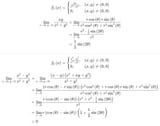>>16774913 (OP)
It's going to be quite easy to show to show something is discontinuous. First, check the limit through some direction. Check if it it equals it at that point. If it doesn't you're done. If not, try to find another path that gives another answer. x=0,y=0, y=x^n, x=y^n are common choices.
For the first, y=x instantly tells me f_1 is discontinuous. For the second, see what happens when you approach from the direction y=0 and y=x.
For the third, maybe a few tests might make you think okay this is continuous. You also might think that as the order of the top term is bigger, it goes to 0 faster than the bottom.
As we are approaching the origin, it is convenient to use polar coordinates and the point is, regardless of what function of theta(r) we have, if r approaches 0, does the function approach 0? If so, it is continuous. See where that gets you.

